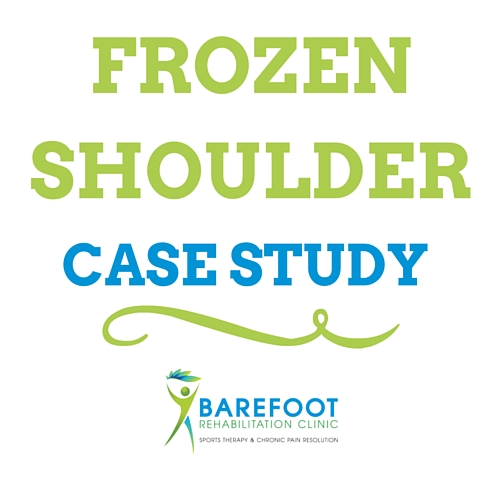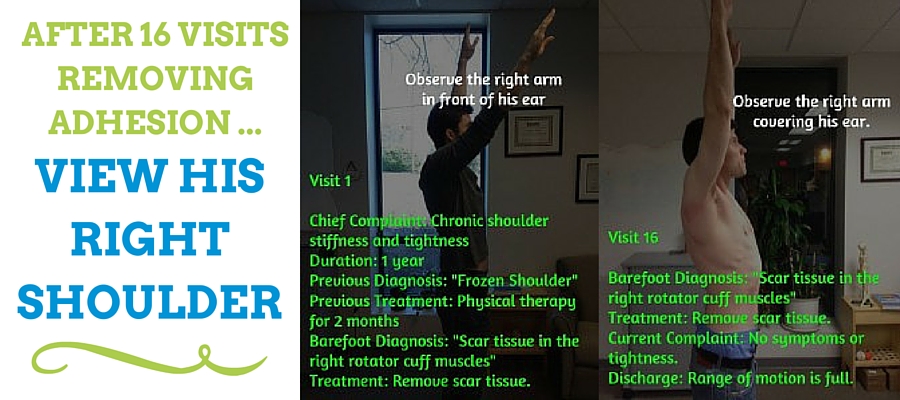
28 Jan Case Study: Frozen Shoulder Success
Disclaimer: The pathologies “adhesion” and “scar tissue” are used interchangeably here in our discussion of frozen shoulder. In medical terms, the only difference between the two is that an “adhesion” implies connective tissue build up without trauma while “scar tissue” implies with trauma.
I’ve already written how I don’t care about your herniated disc and the truth about plantar fasciitis.
Now, it’s time to write about something else I don’t care about.
Your frozen shoulder diagnosis. And a real case study to prove results!
Meet: Jeff
The patient to the right, Jeff, was diagnosed with a “frozen shoulder”, also known as “adhesive capsulitis” (wikipedia). He experienced this condition as “stiffness and tightness” in his right shoulder that began over 18 months before his first visit with Barefoot Rehab.
Previously, Jeff had undergone “physical therapy” treatment for 2 months, starting 15 months before his first visit with Barefoot Rehab. Traditional physical therapy uses many modalities such as ultrasound, electronic stimulation, different variations of massage, and strengthening work. Jeff noted that the “physical therapy” consisted mainly of exercises.
Here, we can assume based on his past treatment that “weakness” was the primary pathology being treated by the previous physical therapists, then “strengthening” would be the primary solution.
Remember, we always have to match up the pathology with the correct treatment for that pathology.
- Pathology –> Solution
- Nail –> Hammer (metaphor for using the proper tool for the proper problem)
- Screw –> Screwdriver
- Weakness –> Strengthening or “Physical Therapy”
He noted this treatment made his range “somewhat better”, but he still couldn’t reach overhead. In the picture above, notice his right arm in front of his ear. He couldn’t lift it any higher than that position and he felt a “soft, bouncy” stop at the top of his range of motion.
His range was far from normal.
Enter: Barefoot Rehab
At his first visit with us, Jeff was able to reach his shoulder about 140 degrees from his side with intense effort.
After palpating (fancy doctor word for “feeling”) various shoulder tissues including infraspinatus, teres minor, subscapularis, and the posterior-inferior shoulder capsule, we were able to determine that Jeff’s primary issue was “Adhesion/Scar tissue in the right rotator cuff muscles.”
- Adhesion –> Adhesion manipulation
Upon further examination of his history, it was determined that Jeff makes relative good lifestyle choices: he consumes alcohol minimally, does not smoke cigarettes, eats his vegetables, has effective stress management techniques, and has a regular exercise routine. In other words, these common pathologies were minimized as problems for Jeff.
The only contributing factor to his diagnosis was his occupation, which causes him to sit at a desk for eight hours/day. This was explained to Jeff. We included in Jeff’s treatment plan overhead movements such as a strict press and yoga movements such as downward dog to assist in maintaining full shoulder flexion.
- Sedentary job –> 2 minute microbreaks for every 30 minutes of sitting consisting of walking, lunging, shoulder circles.
Bye Jeff
After 16 visits, Jeff was able to reach his shoulder 180 degrees from his side, almost touching his ear. This is just shy of what a normal, healthy range would be (his arm in contact his ear).
He noted that it felt easy and he had no stiffness or tightness.
Jeff was discharged, happy with the results he achieved and comfortable knowing that he wouldn’t be putting stress on a tight shoulder joint that could leave him with a ragged, arthritic shoulder at age 50.

How Will Your Flexibility Change Each Visit? (another case study video)
Below is a woman who had 10 years of frozen shoulder and 2 surgeries. The treatment was not recorded. She was 90% better after 7 treatments.
But you can clearly see how her flexibility and range of motion changes after each visit.
You can even hear her friend’s surprise at how well she is moving!
Other Important Notes on the Frozen Shoulder Diagnosis
Jeff responded extremely well to our treatment (manual adhesion release) of one pathology (adhesion).
In true frozen shoulder cases, this is rare.
Frozen shoulder can involve several other dysfunctions that are important to point out:
- Structural dysfunction – ie. labral tears, internal disc derangements or other disc pathology of the cervical spine.
- Metabolic dysfunction – ie. micronutrient deficiencies, food allergies/intolerances, under-the-radar medical conditions, or other immune-comprised problems
- Stress dysfunction – too much sympathetic nervous system overload.
- Emotional dysfunction – ie. an emotional story that necessitates possible Freudian intervention or another therapy of the sort.
In addressing the above list, it’s important to be mindful of non-musculoskeletal caues for a diagnosis like “frozen shoulder”. Only by identifying all non-normal variations from the norm when it comes to our individual health and happiness can we get rid of chronic pain.
 Comment below: How long have your frozen shoulder symptoms lasted? And how many different providers have you tried to get the right diagnosis?
Comment below: How long have your frozen shoulder symptoms lasted? And how many different providers have you tried to get the right diagnosis?

Case Study: Frozen Shoulder Success | Primal Docs
Posted at 16:10h, 28 January[…] Case Study: Frozen Shoulder Success […]
Charlene henry
Posted at 18:10h, 06 FebruarySo you’re stating he was “lazy” and that’s how he developed frozen shoulder?? What about the majority of us who develop it because we are the complete opposite? I do triple as much as I’m suppose to do daily and have always lifted and carried way more than my little body should handle. That was why I was told I developed it and why I am having trouble in BOTH shoulders at the same time. I’m confused on this article…
Dr. Chris
Posted at 20:48h, 06 FebruaryHi Charlene,
Where did you deduce that Jeff was “lazy”? I did say that he has a desk job, where he sits 8 hours/day. But I also mentioned that he has a regular exercise routine. I’m suggesting that he developed frozen shoulder as a result of overuse with adhesion being laid down, tightening his tissue and range of motion. Exactly what caused the overuse is hard to say given this data.
If you overused your rotator cuff musculature and didn’t give your muscles a chance to recover, that’s a really good environment to develop “frozen shoulder” or adhesion in your rotator cuff. Have you been undergoing treatment for them? Is it working? If you want to take a picture/video of your range of motion, I can look at it.
Let me know if this helps to clarify. Let’s have a dialogue and I can help you figure out a diagnosis.
kaleem mohd
Posted at 06:29h, 13 AprilEvidence for physiotherapy to manage true frozen shoulder have been conflicting over the years. As a physical therapist at healthclues, Hyderabad In my experience, in the early stages of the condition, physiotherapy can be extremely useful for pain reduction. However, the movement often remains restricted. There is, however, research supporting physiotherapy in the middle to late stages of the condition as well as after more invasive input. After such a long period of immobility, the shoulder needs lots of encouragement and muscle patterning retraining to rehabilitate back to full function.
Dr. Chris
Posted at 14:26h, 13 AprilThank you for the perspective Kaleem.
Aubrey Corcoran
Posted at 11:56h, 27 MarchI’m a middle aged female Crossfitter who developed frozen shoulder a full 14 months ago. I suffered through 5 months of 2x weekly physical therapy before insurance would cover an MRI. Once I had a correct diagnosis (no tears, but I did have adhesive capsulitis) I had a recommendation from my orthopedic surgeon to try a different PT clinic. Within 2 months of 2 hours, 2x week (so a total of 32 hours) of PT, which included adhesion release (manipulation, extremely uncomfortable) I had significant measurable success. I am now at full ROM and have resumed pull ups and overhead presses. I am still not up to my previous level of strength, and I do have a twinge of tightness in my affected shoulder, but the adhesions HAD to be broken to get where I am. So thankful for my surgeon’s advice.
Dr. Chris
Posted at 20:05h, 27 MarchBeautiful Aubrey. This is what success looks like. Yes, thank God for your surgeon. : )
Brittany Jennings
Posted at 06:31h, 12 AprilThank you for posting
Dr. Chris
Posted at 16:11h, 20 AprilYou’re welcome Brittany!